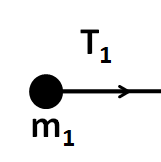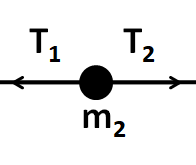
Three solids of mass $ {m_1} $ , $ {m_2} $ and $ {m_3} $ are connected with weight less string in succession and are placed on a frictionless table. If the mass $ {m_3} $ is dragged with a force $ T $ . The tension in the string between $ {m_2} $ and $ {m_3} $ is:-
(A) $ \dfrac{{{m_2}}}{{{m_1} + {m_2} + {m_3}}}T $
(B) $ \dfrac{{{m_3}}}{{{m_1} + {m_2} + {m_3}}}T $
(C) $ \dfrac{{{m_1} + {m_2}}}{{{m_1} + {m_2} + {m_3}}}T $
(D) $ \dfrac{{{m_2} + {m_3}}}{{{m_1} + {m_2} + {m_3}}}T $
Answer
554.7k+ views
Hint To solve this question, we have to determine the common acceleration of the whole system of the three masses. Then, by applying Newton's second and third laws we will get the final value of the required tension.
Formula Used: The formula used to solve this question is given by
$\Rightarrow F = ma $ , here $ F $ is the force acting on a body of mass $ m $ which is having an acceleration of $ a $ .
Complete step by step answer
Consider the system of masses connected by strings in succession as shown in the figure below. Let the tension in the string between the masses $ {m_1} $ and $ {m_2} $ be $ {T_1} $ and that between the masses $ {m_2} $ and $ {m_3} $ be $ {T_2} $

Let the common acceleration of the system be $ a $ .
As we can clearly see, the only external force on this system is the force $ T $ . So from the equation of the whole system we have,
$\Rightarrow F = T $ …………………………...(1)
Also, the total mass of this system is
$\Rightarrow M = {m_1} + {m_2} + {m_3} $ …………………………...(2)
So from the Newton’s second law of motion we have
$\Rightarrow F = Ma $
Putting the values from (1) and (2) we get
$\Rightarrow T = \left( {{m_1} + {m_2} + {m_3}} \right)a $
So we get the common acceleration of the system as
$\Rightarrow a = \dfrac{T}{{\left( {{m_1} + {m_2} + {m_3}} \right)}} $ …………………………...(3)
Now, consider the free body diagram of the mass $ {m_1} $ .

We can see that the net force on $ {m_1} $ is
$\Rightarrow {F_1} = {T_1} $ …………………………...(4)
Also, its acceleration is equal to the acceleration of the system. So, from the Newton’s second law we get
$\Rightarrow {F_1} = {m_1}a $
From (3) and (4)
$\Rightarrow {T_1} = {m_1}\dfrac{T}{{\left( {{m_1} + {m_2} + {m_3}} \right)}} $
$\Rightarrow {T_1} = \dfrac{{{m_1}}}{{\left( {{m_1} + {m_2} + {m_3}} \right)}}T $ …………………………...(5)
Now, we consider the free body diagram of the mass $ {m_2} $ .

We can see that the net force on $ {m_2} $ is
$\Rightarrow {F_2} = {T_2} - {T_1} $ …………………………...(6)
From the Newton’s second law we get
$\Rightarrow {F_2} = {m_2}a $
From (3) and (6) by substituting we get
$\Rightarrow {T_2} - {T_1} = {m_2}\dfrac{T}{{\left( {{m_1} + {m_2} + {m_3}} \right)}} $
From (5) we can substitute the value of $ {T_1} $ . So we get,
$\Rightarrow {T_2} - \dfrac{{{m_1}}}{{\left( {{m_1} + {m_2} + {m_3}} \right)}}T = {m_2}\dfrac{T}{{\left( {{m_1} + {m_2} + {m_3}} \right)}} $
Therefore the tension $ {T_2} $ is
$\Rightarrow {T_2} = \dfrac{{{m_1}}}{{\left( {{m_1} + {m_2} + {m_3}} \right)}}T + {m_2}\dfrac{T}{{\left( {{m_1} + {m_2} + {m_3}} \right)}} $
On simplifying, we get
$\Rightarrow {T_2} = \dfrac{{{m_1} + {m_2}}}{{{m_1} + {m_2} + {m_3}}}T $
Therefore, the tension in the string connecting the masses $ {m_2} $ and $ {m_3} $ is equal to $ \dfrac{{{m_1} + {m_2}}}{{{m_1} + {m_2} + {m_3}}}T $
Hence the correct answer is option C.
Note
Instead of considering the free body diagrams of the masses $ {m_1} $ and $ {m_2} $ , we could have considered that of the mass $ {m_3} $ only. By applying Newton’s second law on the motion of the mass $ {m_3} $ , we could have directly got the required value of the tension.
Formula Used: The formula used to solve this question is given by
$\Rightarrow F = ma $ , here $ F $ is the force acting on a body of mass $ m $ which is having an acceleration of $ a $ .
Complete step by step answer
Consider the system of masses connected by strings in succession as shown in the figure below. Let the tension in the string between the masses $ {m_1} $ and $ {m_2} $ be $ {T_1} $ and that between the masses $ {m_2} $ and $ {m_3} $ be $ {T_2} $

Let the common acceleration of the system be $ a $ .
As we can clearly see, the only external force on this system is the force $ T $ . So from the equation of the whole system we have,
$\Rightarrow F = T $ …………………………...(1)
Also, the total mass of this system is
$\Rightarrow M = {m_1} + {m_2} + {m_3} $ …………………………...(2)
So from the Newton’s second law of motion we have
$\Rightarrow F = Ma $
Putting the values from (1) and (2) we get
$\Rightarrow T = \left( {{m_1} + {m_2} + {m_3}} \right)a $
So we get the common acceleration of the system as
$\Rightarrow a = \dfrac{T}{{\left( {{m_1} + {m_2} + {m_3}} \right)}} $ …………………………...(3)
Now, consider the free body diagram of the mass $ {m_1} $ .

We can see that the net force on $ {m_1} $ is
$\Rightarrow {F_1} = {T_1} $ …………………………...(4)
Also, its acceleration is equal to the acceleration of the system. So, from the Newton’s second law we get
$\Rightarrow {F_1} = {m_1}a $
From (3) and (4)
$\Rightarrow {T_1} = {m_1}\dfrac{T}{{\left( {{m_1} + {m_2} + {m_3}} \right)}} $
$\Rightarrow {T_1} = \dfrac{{{m_1}}}{{\left( {{m_1} + {m_2} + {m_3}} \right)}}T $ …………………………...(5)
Now, we consider the free body diagram of the mass $ {m_2} $ .

We can see that the net force on $ {m_2} $ is
$\Rightarrow {F_2} = {T_2} - {T_1} $ …………………………...(6)
From the Newton’s second law we get
$\Rightarrow {F_2} = {m_2}a $
From (3) and (6) by substituting we get
$\Rightarrow {T_2} - {T_1} = {m_2}\dfrac{T}{{\left( {{m_1} + {m_2} + {m_3}} \right)}} $
From (5) we can substitute the value of $ {T_1} $ . So we get,
$\Rightarrow {T_2} - \dfrac{{{m_1}}}{{\left( {{m_1} + {m_2} + {m_3}} \right)}}T = {m_2}\dfrac{T}{{\left( {{m_1} + {m_2} + {m_3}} \right)}} $
Therefore the tension $ {T_2} $ is
$\Rightarrow {T_2} = \dfrac{{{m_1}}}{{\left( {{m_1} + {m_2} + {m_3}} \right)}}T + {m_2}\dfrac{T}{{\left( {{m_1} + {m_2} + {m_3}} \right)}} $
On simplifying, we get
$\Rightarrow {T_2} = \dfrac{{{m_1} + {m_2}}}{{{m_1} + {m_2} + {m_3}}}T $
Therefore, the tension in the string connecting the masses $ {m_2} $ and $ {m_3} $ is equal to $ \dfrac{{{m_1} + {m_2}}}{{{m_1} + {m_2} + {m_3}}}T $
Hence the correct answer is option C.
Note
Instead of considering the free body diagrams of the masses $ {m_1} $ and $ {m_2} $ , we could have considered that of the mass $ {m_3} $ only. By applying Newton’s second law on the motion of the mass $ {m_3} $ , we could have directly got the required value of the tension.
Recently Updated Pages
Why are manures considered better than fertilizers class 11 biology CBSE

Find the coordinates of the midpoint of the line segment class 11 maths CBSE

Distinguish between static friction limiting friction class 11 physics CBSE

The Chairman of the constituent Assembly was A Jawaharlal class 11 social science CBSE

The first National Commission on Labour NCL submitted class 11 social science CBSE

Number of all subshell of n + l 7 is A 4 B 5 C 6 D class 11 chemistry CBSE

Trending doubts
What is meant by exothermic and endothermic reactions class 11 chemistry CBSE

10 examples of friction in our daily life

One Metric ton is equal to kg A 10000 B 1000 C 100 class 11 physics CBSE

1 Quintal is equal to a 110 kg b 10 kg c 100kg d 1000 class 11 physics CBSE

Difference Between Prokaryotic Cells and Eukaryotic Cells

What are Quantum numbers Explain the quantum number class 11 chemistry CBSE




